After years of reviewing dive watches professionally, I’ve handled everything from budget-friendly beaters to premium tool watches and I’ve developed a clear critical sense of what makes certain models stand out from others. The best dive watches aren’t just functional. They’re thoughtfully designed, aesthetically distinct, and priced with intention. For most modern collectors, a dive watch is a foundational piece: one of the most versatile and purpose-driven watches you can research, buy, and wear daily.

The most compelling examples balance critical features like durability, legibility, and water resistance with a clear design vision that elevates them beyond spec sheets. And while the process of comparing movements, case profiles, and collector opinions can be overwhelming, it’s often worth the effort. To make that process easier I’ve assembled this evolving list of top-value picks, each tested hands-on by myself and our review team. Some are widely recognized, while others you’ll rarely see mentioned anywhere else; however, each have been chosen for how well they merge everyday utility, standout design and affordability.
Invicta Pro Diver
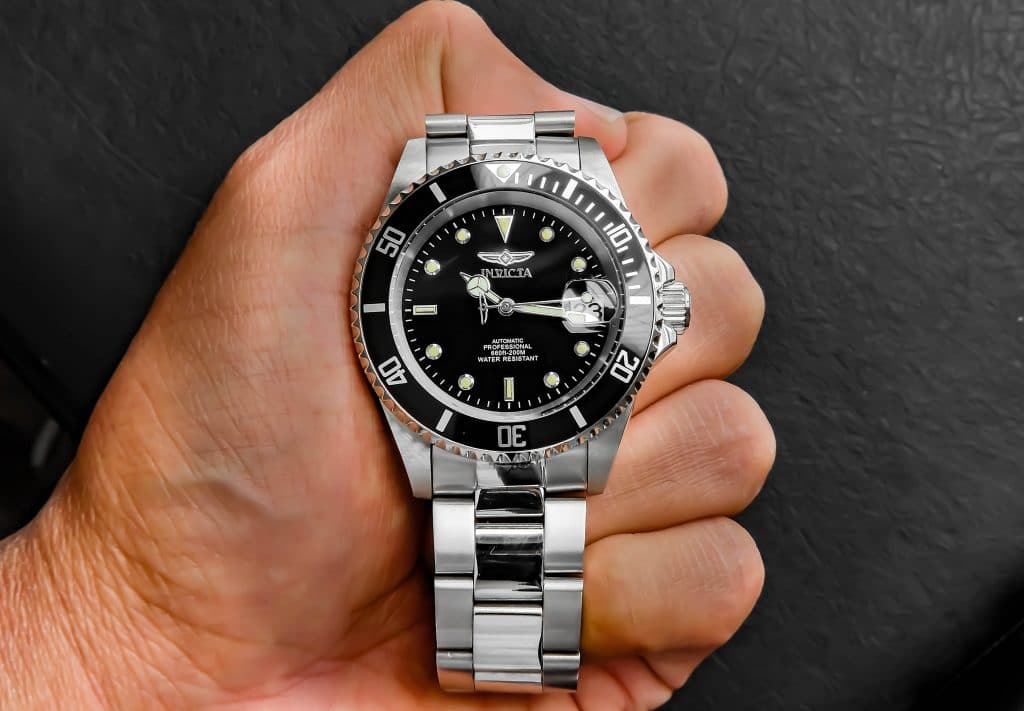
| Price Range: | $65 – $100 |
| Water Resistance: | 200m |
| Case Dimensions: | 40mm x 48mm x 14mm |
| Lug Width: | 20mm |
| Movement: | Seiko NH35 (Mechanical Movement) |
There’s no shortage of opinions when it comes to the Invicta Pro Diver. You’ll usually see all the same online snark about it being a low quality homage or something about how it’s not as reliable as other watches. But after years of reading other people’s thoughts, the TBWS review team and I decided to test the timepiece for ourselves. We discovered that the Pro Diver not only punches above its weight – it rewrites the expectations for what a sub-$100 automatic can be. We purchased ours model from Amazon, which is generally where you’re going to find the best deals.
During the course of our review we experienced a 40mm case that immediately sat right, a bezel that’s surprisingly useful in day-to-day tasks, and a bracelet that—while not perfect—felt sturdier than we expected. The polished center links and hollow end-links of the bracelet won’t fool anyone into thinking it’s ultra-high quality, but they also don’t cheapen the experience (given the affordable price) unless you’re actively looking to nitpick. More importantly, the NH35 movement inside makes the watch feel like a serious tool, not a toy, and that’s where this model earns its keep.
The crown is very easy to grip while the case finishing walks a fine line between somewhat unrefined in certain areas but still incredibly wearable. Also, even though the lume and dial details show signs of cost-cutting, nothing here feels careless. Unlike other Pro Diver variants that felt more ornamental than functional, this one finally delivers a tool-forward package that doesn’t feel like a compromise when you factor in the price. If Invicta had left off the loud branding on the case side, I suspect more people would have stopped calling this a knockoff and started recognizing it for what it actually is: one of the most affordable, feature-rich automatic dive watches on the market. You can read more about our hands-on experience in the Pro Diver Review.
Orient Mako II
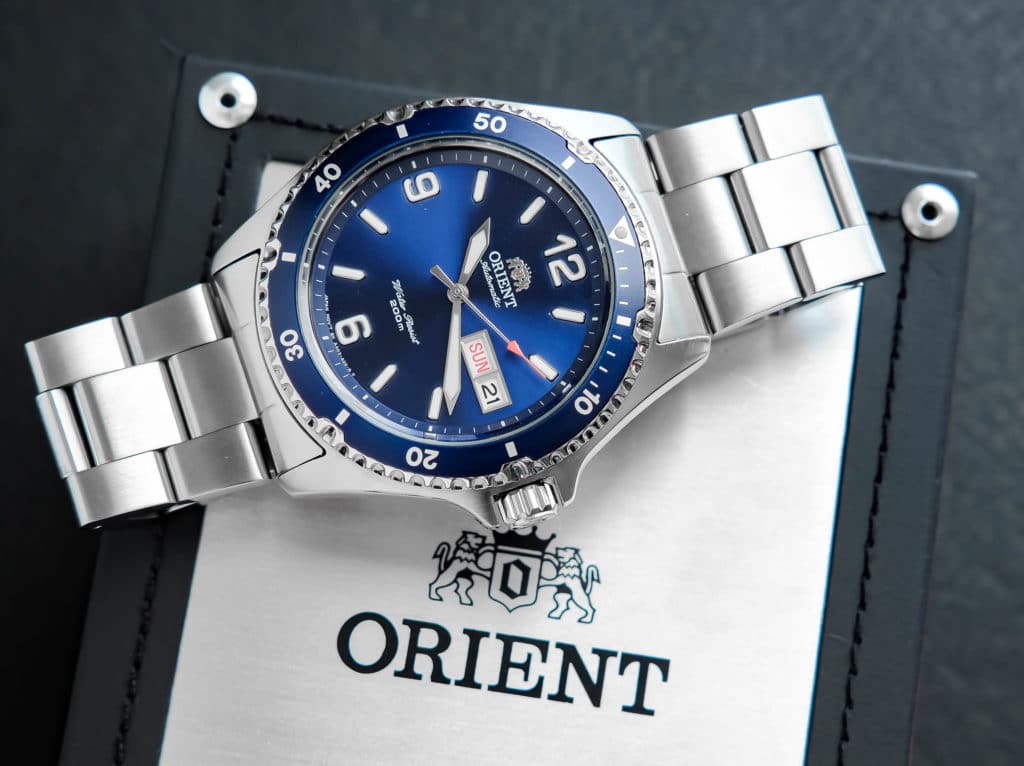
| Price Range: | $160 – $220 |
| Water Resistance: | 200m |
| Case Dimensions: | 41.5mm x 47mm x 13mm |
| Lug Width: | 22mm |
| Movement: | Orient Caliber F6922 (Mechanical Movement) |
Most budget dive watches ask you to make some sort of quality concession – alignment issues, cheap bracelets, or dials that look better in photos than they do on the wrist. But the Orient Mako II barely asks of that at all. During testing we found a surprisingly dialed-in 41.5mm diver with just the right case balance, a crisp sunburst that shifts in low light, and a bracelet that finally feels like it belongs with the case. Plus, the new F6922 movement of this new upgraded generation brings the Mako II into modern dive watch territory: hacking, manual wind, no weird 2 o’clock pusher, and just enough bite in the winding action to remind you it’s mechanical.
What really sets this timepiece apart from other divers at this price is that most watches will lean on the NH35 automatic movement or something quartz powered. But the Mako II is a full in-house automatic dive watch that is executed incredibly well. The polished and brushed transitions of the case and bracelet show a level of care we don’t usually associate with sub-$200 automatics, and even the sloped bezel, while tricky to grip, turns with a reassuring click once you find the right angle. Orient’s not loud about what they’re offering here, but this version of the Mako II is hands-down one of the best options for someone in the market for a high quality, spec-heavy affordable dive watch. If you’d like to research the watch more please check out our full review.
Orient Ray II
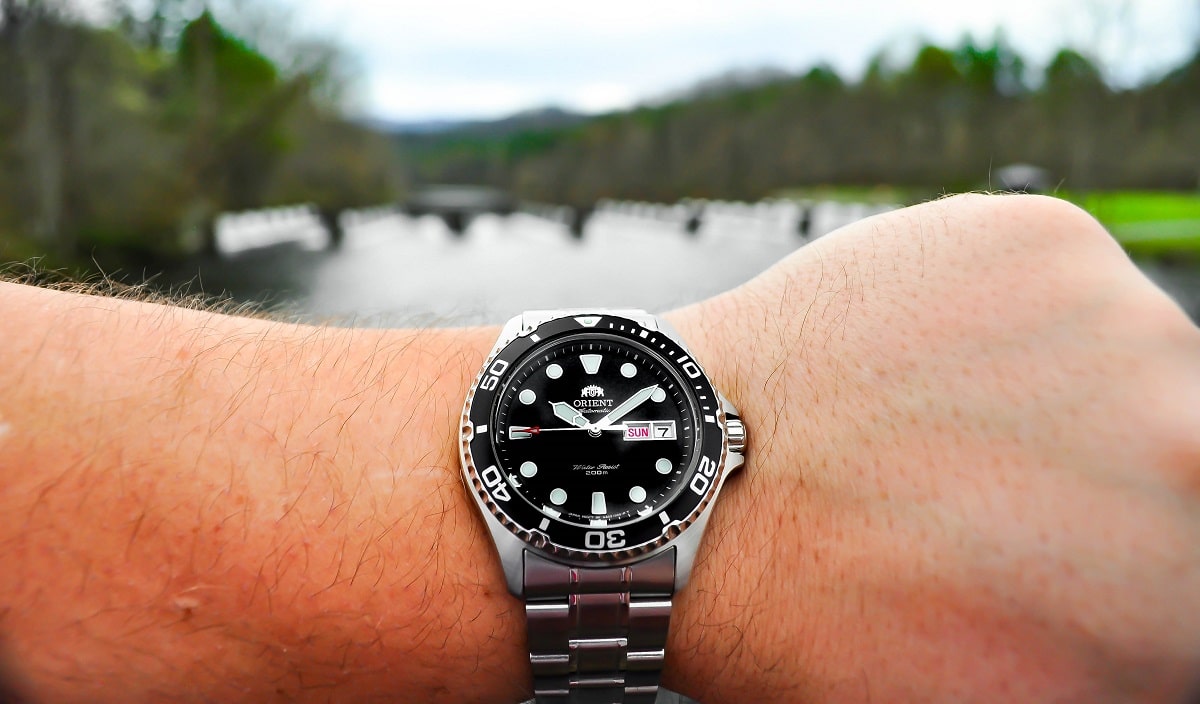
| Price Range: | $160 – $220 |
| Water Resistance: | 200m |
| Case Dimensions: | 41.5mm x 47mm x 13mm |
| Lug Width: | 22mm |
| Movement: | Orient Caliber F6922 (Mechanical Movement) |
Where the Mako II leans sporty, the Orient Ray II dresses things up just enough to pass for something sharper without giving up its dive watch credibility. After reviewing both iconic Orient divers, the Ray II stands apart not just in styling, but in how refined it feels day to day. Compared to the original Ray, this version upgrades the movement with hand-winding and hacking, and replaces the awkward day-pusher with full crown control (the same upgrades we noted in the Mako II). The matte black dial and bezel on the version we revied created a more dressier silhouette, while the bold indices and wide bezel font keep it grounded in functional dive watch territory.
The 41.5mm case wears just as comfortably as its sibling, but we did wrestle a bit with the crown since it’s small, overly polished, and half-buried in the guards. On the flip side, the lume, clasp, and highly legible day-date layout more than earn their keep. The bracelet isn’t perfect, but even with the rattly end-links, the whole package comes together better than you’d expect for a diver under $200. The Ray II might not be the most popular piece in Orient’s lineup, but for anyone wanting design versatility without trading away spec or value, it hits a real sweet spot. You can also read more about our in-depth testing of this watch in our review.
Redwood Tactical Diver’s Watch
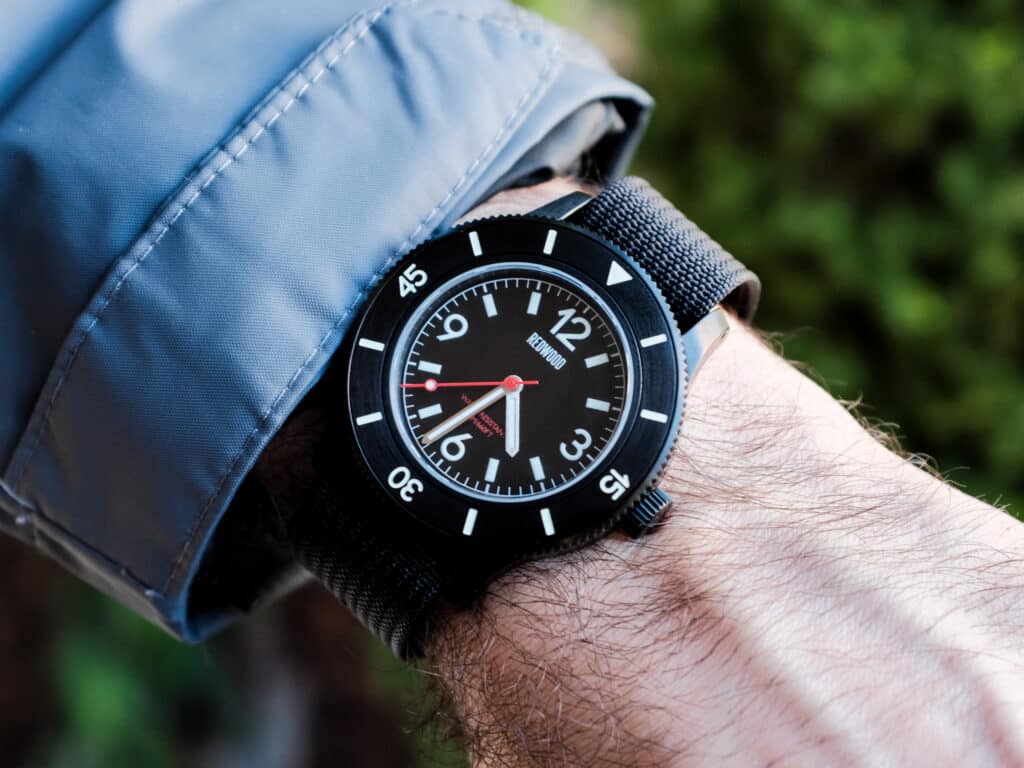
| Price: | $200 |
| Water Resistance: | 200m |
| Case Dimensions: | 40mm x 48mm x 11.2mm |
| Lug Width: | 20mm |
| Movement: | Epson VS17 (Solar Quartz Movement) |
Some microbrands try to capitalize on design trends or gimmicks with novelty dials, but Redwood went the opposite direction. They leaned into function and familiarity with their Tactical Diver’s Watch. Our initial impression while reviewing the watch is that it looks like someone finally asked what a field-capable diver should look like in the modern era then skipped the fluff and just built it. We reviewed the solar quartz version, which runs on the Epson VS17 and outperforms any iteration of mechanical movement out there due to it’s accuracy and not needing to constantly wind and set the time.
Between the 40mm case, the 11.2mm height, and the smooth wear on the ribbed nylon strap, this watch disappears on the wrist in the best way possible. The dial stays bold and clear in low light, and the bezel action is solid without that flimsy looseness you sometimes get on dive watches in this price range. It’s not trying to be flashy, but there’s real precision in the way it riffs on old spec-driven military divers. Redwood’s not one of the most popular microbrands, but they’re one of the few out there making budget dive watches that are solar powered for $200. We had an amazing time reviewing and testing this diver, which you can see more of in our full review.
Citizen Promaster Diver Eco-Drive
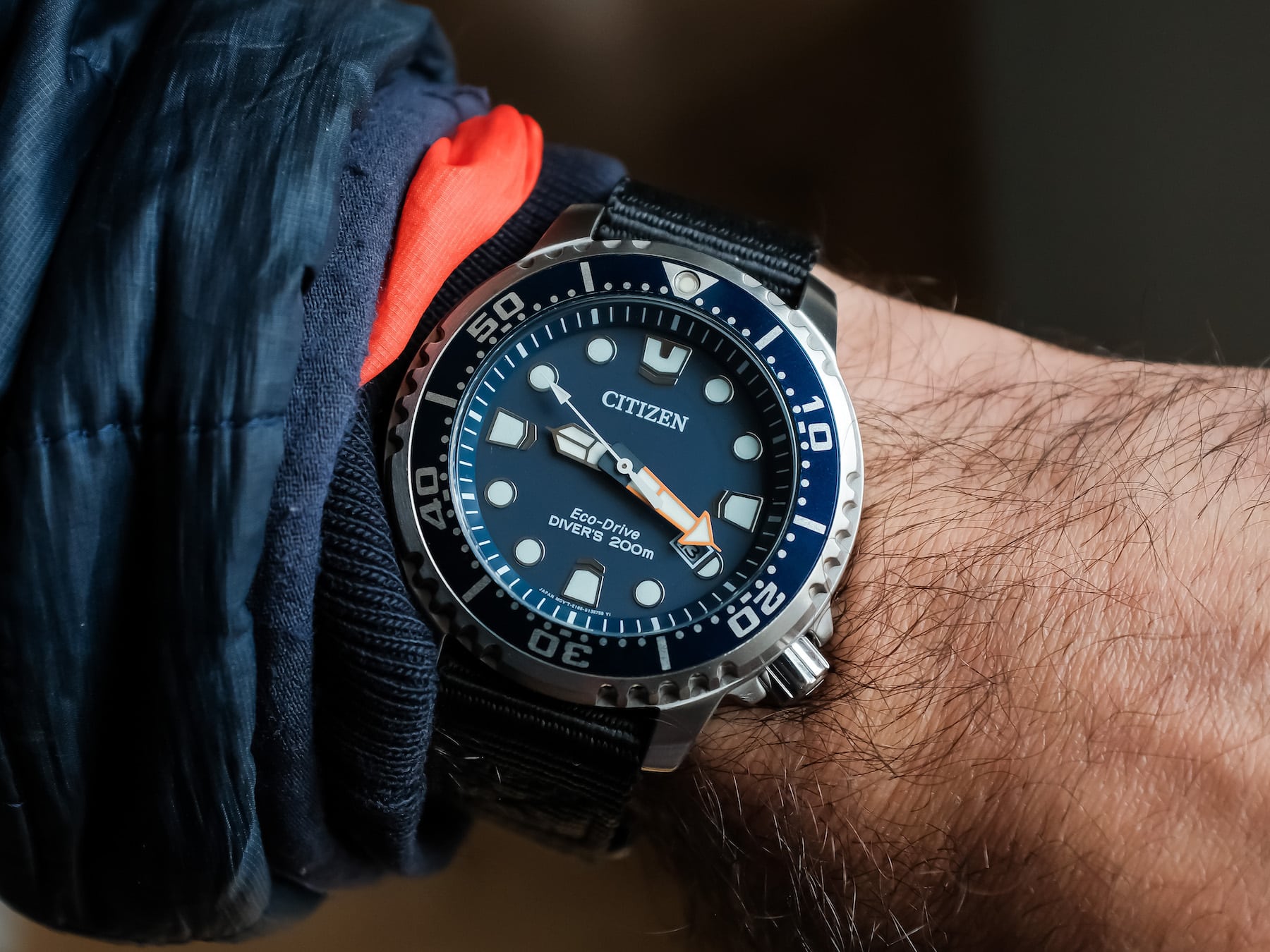
| Price Range: | $200 – $300 |
| Water Resistance: | 200m |
| Case Dimensions: | 43mm x 48mm x 11.5mm |
| Lug Width: | 20mm |
| Movement: | Citizen E168 (Eco-Drive Solar Quartz) |
For years now, the Citizen Promaster Diver has been one of the most recommended watches we share when someone ask for a dependable, under-the-radar diver that won’t punish your wallet. Our team has extensively reviewed this timepiece since it’s in Michael Penate’s (one of our Co-Founder’s) personal collection. Our hands-on impression is that there is an overall highly accessible reliability that’s hard to find among dive watches in this price range – it’s powered by the sun, hyper-accurate, and features a high 200m of water resistance for real world water.
Compared to other divers in Citizen’s collection, this particular model we’re reviewing (ref. BN0151-09L) cuts down on bulk and softens the lug profile, which makes a big difference in daily wear and wrist comfort. The Eco-Drive E168 solar movement powering the watch runs for six months from a single charge charge, and with a 43mm case that wears closer to 40 thanks to short lugs, it disappears whether you’re wearing it on a rubber or nylon strap. The dial stays readable in everything from office lighting to tidal gloom, and the BGW9 lume doesn’t just cover the basics—it even gives the seconds hand a quiet glow. I’ll admit the stock strap isn’t my favorite, but swapping it for nylon or sailcloth is easy thanks to the 20mm lugs. Plus, between the 60-click bezel, the undercut crown, and the deep blue dial that shifts under changing light, this Promaster proves that function-first and affordability can still mean that a diver is fun to wear. There’s more info and unique insights in our full review.
Orient Kamasu
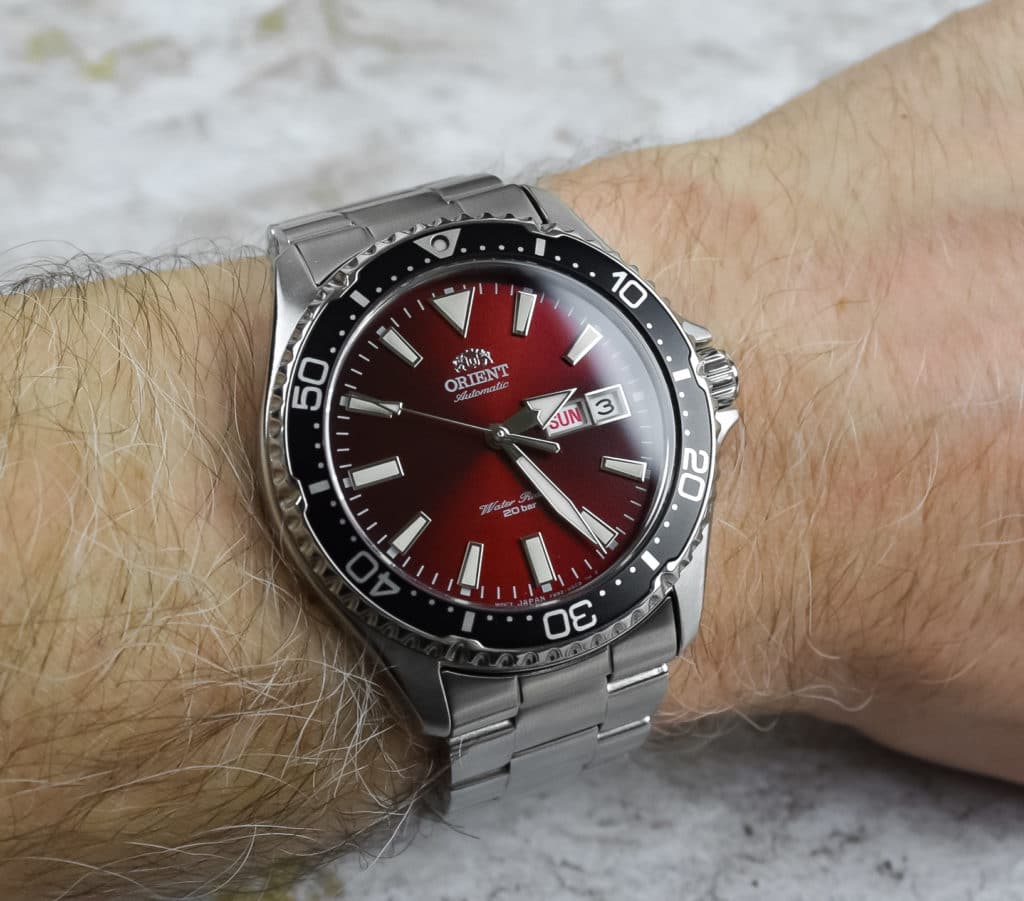
| Price Range: | $200 – $330 |
| Water Resistance: | 200m |
| Case Dimensions: | 41.5 mm x 47mm x 12.8mm |
| Lug Width: | 22mm |
| Movement: | Orient Caliber F6922 (Mechanical) |
The Kamasu feels like the moment Orient decided to really step up their game in the budget dive watch market with sharper geometry, more thoughtful finishing, and a spec sheet that’s hard to fault at the price. It keeps the familiar 41.5mm diameter and 47mm lug-to-lug profile of the other divers in Orient’s collection. But at 12.8mm thick, it’s slightly thinner and slides under the cuff better than you’d expect from a dive watch. Over the course of our hands-on testing we determined that the slight sizing adjustment, paired with the upgraded sapphire crystal and that deep wine sunburst dial, makes it feel like more watch than the $200–$300 price range suggests.
The applied markers give the appearance of floating on the dial due to the lack of a chapter ring, which adds visual depth without cluttering up the dial. The F6922 movement is the same upgraded in-house movement as the Mako II and the Ray II., but with the Kamasu the rest of the build finally feels like it’s catching up. If the coin-edge bezel had a bit more grip and the crown weren’t quite so recessed, our review team would have almost nothing to nitpick. For a diver in this price range, the Kamasu makes a very compelling value argument to not really ever want to spend more. Be sure to learn more about our great experience testing this watch in our review.
Scurfa Diver One
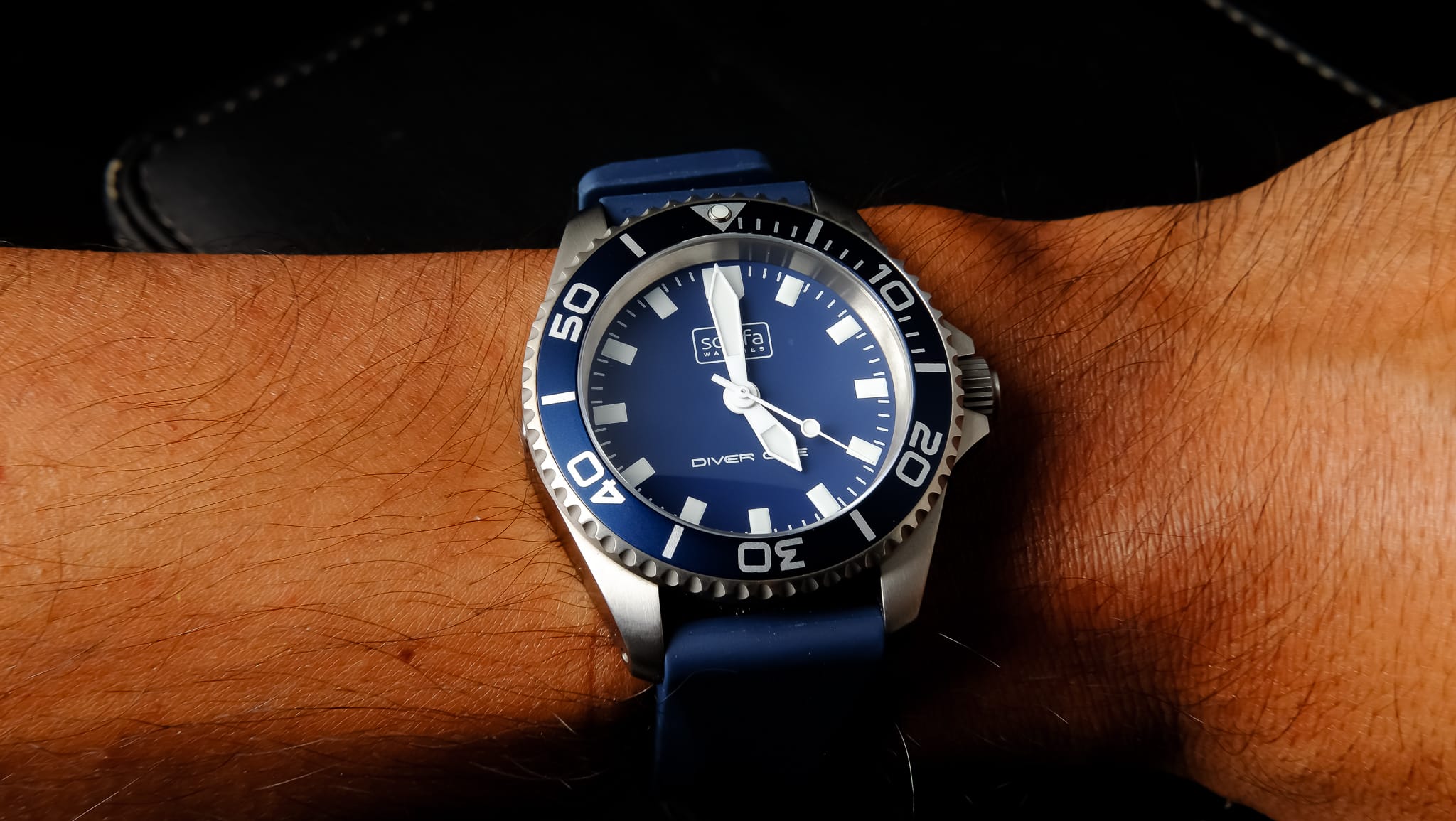
| Price Range: | $250 – $300 |
| Water Resistance: | 500m |
| Case Dimensions: | 40mm x 47mm x 14mm |
| Lug Width: | 20mm |
| Movement: | Ronda 713SM (Quartz Movement) |
Scurfa doesn’t really build watches the way other microbrands do and that becomes obvious the second you pick up the Diver One. These are timepieces created by Paul Scurfield, a professional deep sea diver with a passion for function-driven dive watches and it’s Paul’s background that really separates the Diver One from other microbrand divers. We were able to conduct some hands-on testing of the Diver One in Titanium, which we found to be a more wearable and versatile in both outdoor and professional situations than many other traditional stainless steel counterparts. The lightness of the material on our wrist enhanced both wearability and usability, addressing common concerns about bulk and ease of use with function-first dive watches.
But more than just the case material, the watch is truly purpose built featuring 500m of water resistance, a multi-gasket screw-down crown, helium escape valve, and a domed sapphire that gives just enough vintage distortion without messing up legibility. The lume also holds its own next to any diver from Seiko (I know, we were shocked as well when we saw it during testing), offering incredible multi-environment legibility. Even the bezel has that firm, tool-like action you usually lose in sub-$300 quartz divers. We understand that these specs can seem like overkill, but for professional divers who need and rely on these types of features, everything here is intentional. If you want to learn more you should explore our full review of the Diver One Titanium.
Seiko Turtle
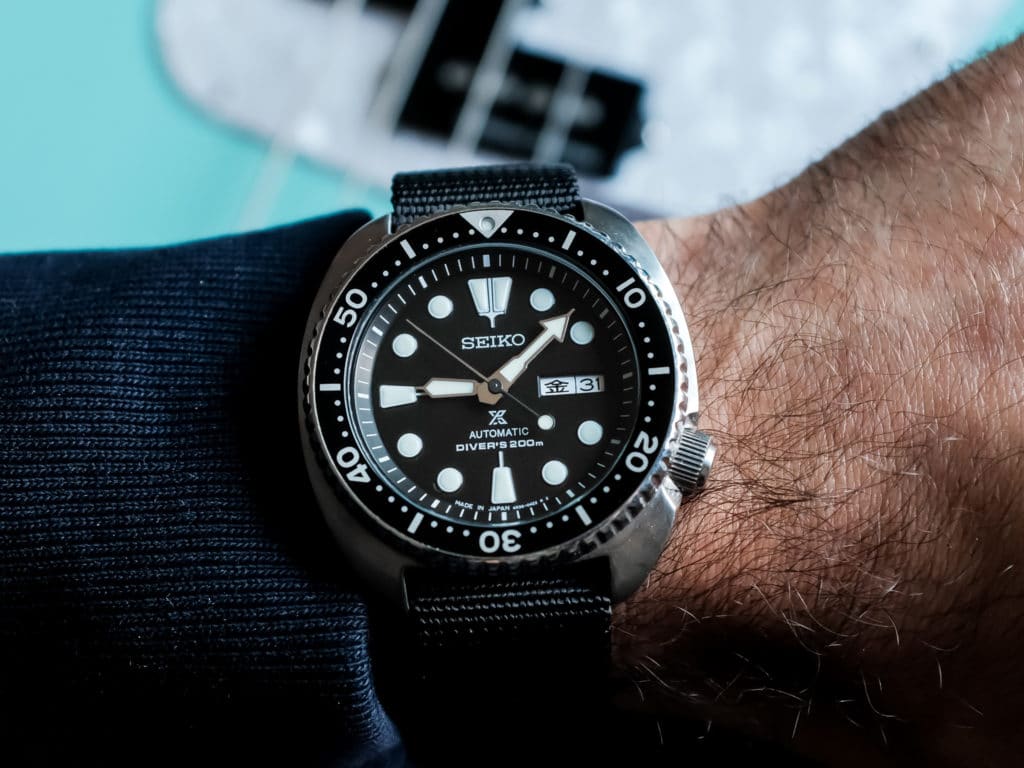
| Price Range: | $380 – $500 |
| Water Resistance: | 200m |
| Case Dimensions: | 44.3mm x 48mm x 14mm |
| Lug Width: | 20mm |
| Movement: | Seiko 4R36 (Mechanical) |
Seiko didn’t just bring the Turtle back in 2016—they kept everything that made the original worth reviving and used modern materials and building practices to make it better. This is another watch that’s featured in Michael Penate’s (our Co-Founder’s) collection, so we’ve had extensive hands-on time to test it. What we really appreciated is how the iconic asymmetric 44.3 case and 48mm lug-to-lug span wore much more comfortably on the wrist than expected. It wears low, keeps clear of the wrist bone, and carries just enough of the original 6309 case design DNA to remind you this isn’t Seiko trying to reinvent anything, it’s picking up where the original case shape left off.
The fully brushed case and vented rubber strap make it feel like a proper tool, and the matte black dial stays readable at any angle, especially with the oversized lume plots and Hardlex crystal. The 4R36 inside gives you hacking and hand-winding (a welcome upgrade over the original’s 7S26). While the stated accuracy of the movement is +45/-35 seconds per day, we actually noted a much better daily accuracy than that. Bezel action is firm, though Seiko’s historic alignment issues were present in the timepiece we reviewed. But truthfully, for under $400 there’s not much we’d change in the Turtle. The lineage of the design, reliability of the build, and wrist comfort you enjoy are bargains compared to other divers offering less benefits. You can learn more about what makes this watch special in our full review.
Seiko Samurai
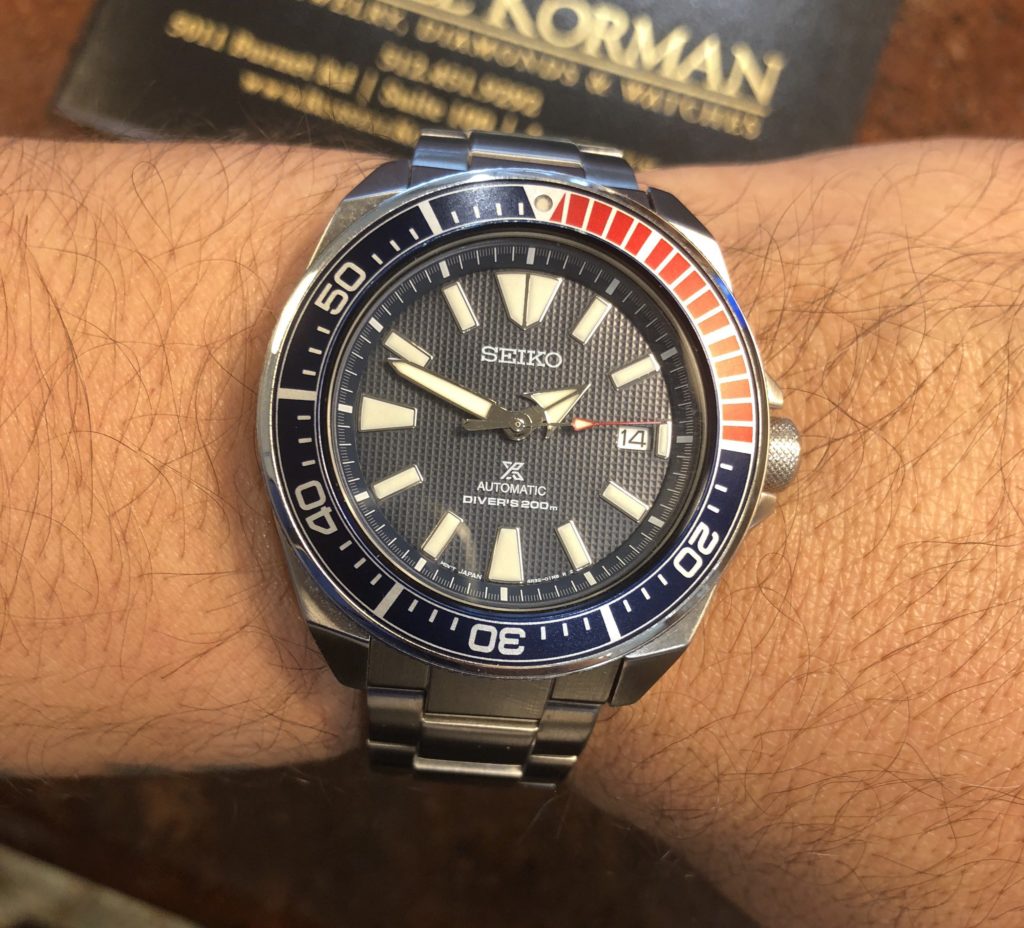
| Price Range: | $400 – $500 |
| Water Resistance: | 200m |
| Case Dimensions: | 43.8mm x 47mm x 13mm |
| Lug Width: | 20mm |
| Movement: | Seiko 4R35 (Mechanical) |
I didn’t expect the Seiko Samurai to feel so different on the wrist from its siblings when it was re-released in 2017. But as soon as we begin testing the watch we became pretty evident that there is no other diver with this case geometry in Seiko’s lineup. On paper the 43.8mm width and 47mm lug-to-lug suggested to us a somewhat balanced wearing experience (which is pretty common for Seiko divers). However the lugs don’t curve down and that makes it sit slightly higher on the wrist compared to the Turtle or Sumo. You’ ‘ll notice it immediately, but that’s not to say the watch is necessarily uncomfortable. The watch is designed to offer a bold wearing experience without necessarily sacrificing comfort – this is not an under the radar design.
This case profile is original to the first Samurai generation released in 2004, however this current generation features some much appreciated improvements. Bezel clicks are sharp and deliberate, with squared knurling that grips cleanly – same goes for the oversized crown tucked into sloped guards on the side of the case profile. Under the Hardlex crystal Seiko’s proprietary lume shines with incredible brightness in low- to no-light situations. The 4R35 movement offers hacking, hand-winding, and an easy service profile that we always appreciate in timepieces that we review. Sometimes you can get dive watches with mechanical movements that aren’t always the easiest to fix if an issue come up. For a diver under $500, the Samurai doesn’t try to tick all the boxes for everyone, however if you’re looking for an incredibly aggressive case design that still wears comfortably and touts Seiko’s build pedigree, this is a contender. You can learn more in our hands-on review.
Imperial Royalguard 200
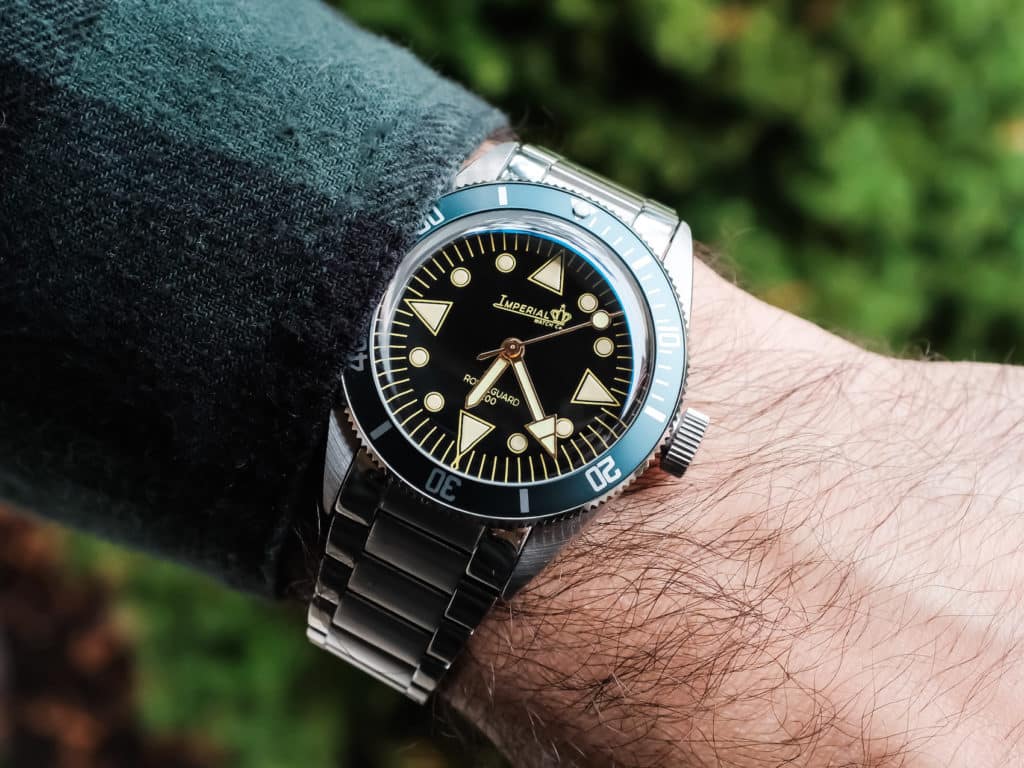
| Price: | $450 |
| Water Resistance: | 200m |
| Case Dimensions: | 38mm x 47mm x 14mm |
| Lug Width: | 20mm |
| Movement: | Seiko NH35 (Mechanical Movement) |
The Royalguard 200 from Imperial Watch Co. was a reminder for our review team of what a microbrand is capable of when its founder comes from the watch modding world. You can see the modding DNA of the design in how it riffs on classic diver cues without leaning into heavy-handed homage territory. But more than the design, we were impressed with the overall execution of the timepiece during our testing. At 38mm across and 14mm thick, it wears snug and centered on the wrist, with drilled lugs and an aluminum bezel insert that shifts through a variety of hues depending on how the light hits it. It measures 47mm lug-to-lug and features 200m of water resistance, so it checks all the practical boxes of a dive watch without overextending its lug-to-lug footprint.
The oversized crown has a solid feel that makes setting or winding it more satisfying than one would have expected, and the bracelet’s taper from 20mm to 16mm keeps the watch looking balanced without wearing small. There’s a visual rhythm to the triangle-on-triangle dial layout that we don’t commonly see and it makes reading the time quite satisfying. The NH35 movement has a ghost date and the clasp is pretty basic, which aren’t ideal. But we still feel confident calling this one of the most character-rich under-$500 watches we’ve ever worn and tested. Especially at this price, it does a better job of feeling personal and thoughtfully built than most other microbrand divers. Learn more about the Royalguard 200 in our hands-on review.
Citizen Promaster Aqualand Depth Meter JP2007-17W
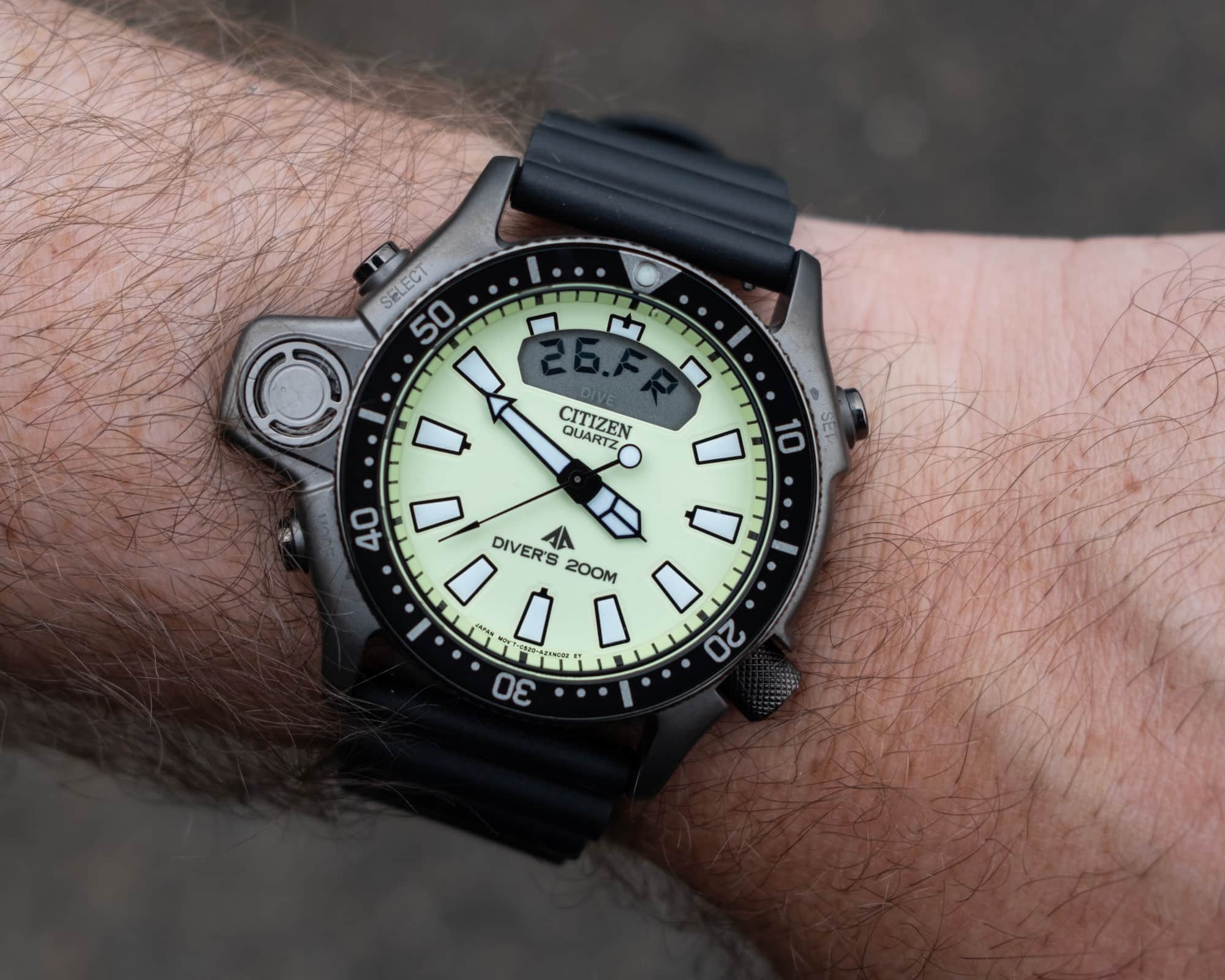
| Price: | $550 |
| Water Resistance: | 200m |
| Case Dimensions: | 50.7mm x 51mm x 14.8mm |
| Lug Width: | 24mm |
| Movement: | Citizen C520 (Solar Movement) |
If there’s anything about the Citizen Promaster Aqualand that should be apparent, it’s that it isn’t a subtle watch. At nearly 51mm in diameter our review team found that it wears very large on the wrist and features a bulbous depth sensor that juts from the case like a submarine port. It’s also 14.8mm thick with a 51mm lug-to-lug span and rated for 200m of water resistance, so the specs at least match the visual intensity of the wearing experience in person. Still, we appreciated during testing how the watch featured a charm in being unapologetically tool-watch centric.
The C520 module tracks dive data for up to four sessions, flashes a rapid ascent warning for safety, and functions underwater without any issue. Compared to earlier Aqualands from the ‘80s, this version feels more refined, but it keeps the same unorthodox charm and uncompromising size it’s known for. The full-lume dial can feel a bit cluttered when it lights up in darkness and the 24mm rubber strap isn’t the most comfortable for casual wear. However, this is not an everyday, casual wearing watch. This is a tool that’s meant to be worn over a dive suit and features all the reliability and functionality you need for an incredibly affordable price of $550 (especially in comparison to other comparable models like the Seiko Arnie). We have a hands-on review with more pros, cons, and unique insights where you can research this piece further if you like.
Nodus Sector Deep
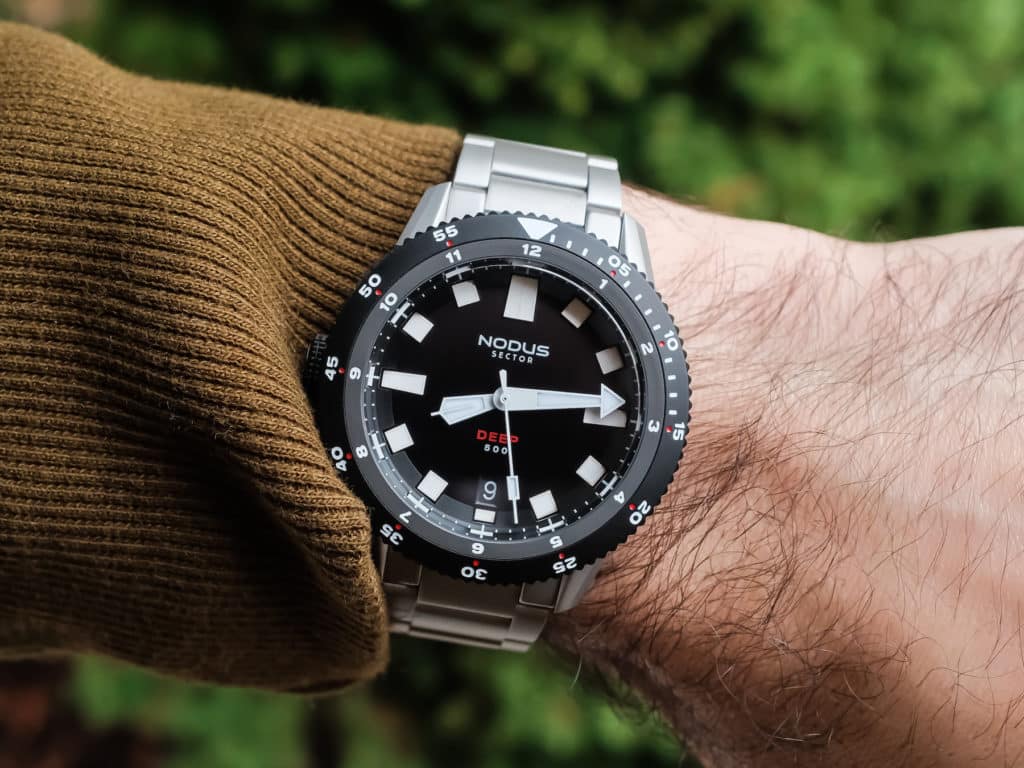
| Price: | $599 |
| Water Resistance: | 500m |
| Case Dimensions: | 42mm x 47mm x 13.6mm |
| Lug Width: | 20mm |
| Movement: | Seiko NH35 (Mechanical Movement) |
The review team and I have handled our fair share of tool divers, but the Sector Deep was the first time we felt that Nodus had pushed their unique design language into genuinely rugged territory without losing the sharp execution that defines their releases. Compared to other models in the Nodus Sector collection, the Deep trades symmetry for utility and gains clarity in the bezel and dial layout. The 38mm case wears low and comfortable despite the 500m rating, which usually renders other watches feeling more top-heavy on the wrist. The left-side crown (aka Destro) was a highlight during our testing both for its visual uniqueness and how it stopped the case from pressing into our wrist throughout the day. Grip on the matte DLC bezel was perfect and the dual-scale timing system on it allowed us to keep tabs on both elapsed time and a second time zone.
We found the NodeX clasp easy to adjust and dial in for multiple wrist sizes, though the full extension does leave a bit of bare hardware visible. What I didn’t expect was how cohesive the whole package would feel – tapered indices, the symmetrical dial layout, and even the subtle red accents gave the Sector Deep a focused, almost mission-ready vibe. At $599, this is easily the best option for anyone looking for the best affordable diver that features multiple functions, a true deep sea diving depth rating, and a smaller than expected case size. You can learn more about this incredible timepiece in our hands-on review.
Baltic Aquascaphe
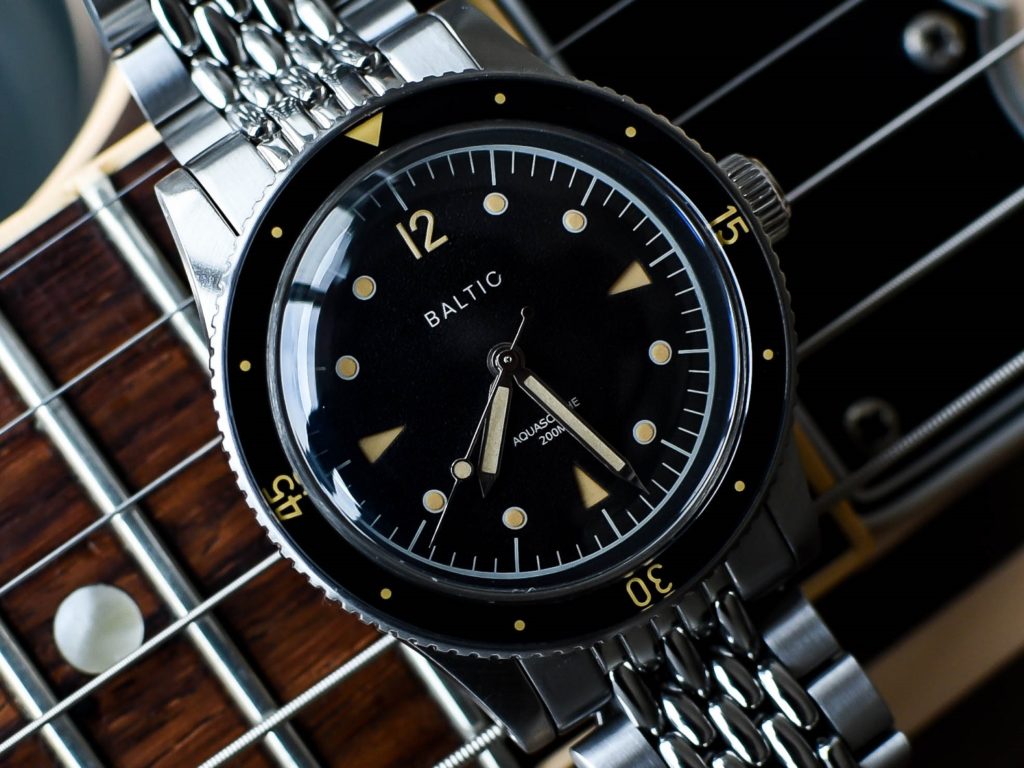
| Price Range: | $650 – $750 |
| Water Resistance: | 200m |
| Case Dimensions: | 39mm x 47mm x 12mm |
| Lug Width: | 20mm |
| Movement: | Miyota 9039 (Mechanical Movement) |
Baltic isn’t creating variations on iconic vintage designs. The French microbrand studies the nuances and subtleties of the design aesthetic to create something that feels old-world familiar without being visually derivative. That’s why their Aquascape diver is so unique among the timepieces on this list. Our review team initially began testing the Aquascaphe expecting a charming microbrand diver, but we immediately noticed how the 39mm case and 47mm lug-to-lug created a compact, planted fit on our wrist that felt more like wearing an original vintage design rather than a modern reissue that was trying to capture a vintage essence.
The case weight is light without feeling hollow, and the sloped profile helped it stay low and stable throughout the day. Strap changes weren’t necessary because the included beads-of-rice bracelet wore quite comfortably and stayed in place over the course of wearing it. The sandwich dial (which features a multi-piece layered dial construction) blends cutout markers with surface lume, and the color tone of the lume pairs well with the gilt accents without tipping into caricature of vintage design. The textured crown was easy to grip and setting the time on the Miyota 9039 felt crisp, even if the winding action of the movement wasn’t the smoothest. The Aquascaphe isn’t trying to recreate the past, but it is using it as a tool to build something that actually wears like it belongs in the present. Our hands-on review has more info about Baltic watches and unique insights from our testing of the Aquascaphe.
Gavox Avidiver

| Price: | $750 |
| Water Resistance: | 200m |
| Case Dimensions: | 43mm x 50.8mm x 12.8mm |
| Lug Width: | 22mm |
| Movement: | Miyota 9015 (Mechanical Movement) |
We weren’t sure what to expect from a watch that tried to merge a pilot dial, a diver’s case, and an internal dive bezel. But the Gavox Avidiver surprised our review team in all the right ways. The 43mm case is stainless steel, 12.8mm thick, and wears flat thanks to the sloped lugs and rubber strap that stays put with smart keeper grooves. You get twin crowns, one of which rotates a lumed triangle inside the dial that can track a second time zone or elapsed time for diving, depending on how you set it.
The 9015 automatic movement powering the watch is unadorned but smooth when winding the watch. The only issue we experienced here was a bit of stiff movement when transitioning from the time setting to the winding position. One of the more unique aspects of this watch that we appreciated during our review is the sandwich dial. While this is the second sandwich dial we’re featuring, the Avidiver’s is more noteworthy simply for the level of detail and functional legibility it adds with the unique dial font, hour markers, and unique triangle at 12 o’clock. Gavox isn’t trying to mimic or riff on any specific design with the Avidiver. Instead they’re a microbrand that is truly trying to create something unique and passion driven, which certainly comes across in this timepiece. For more info on Gavox Watches and our experience with the Avidiver, head over to our hands-on review.
How To Research And Find The Right Dive Watch For You
Finding a reliable and affordable dive watch starts with understanding what makes a dive watch functional in the first place. The most critical spec to look out for is water resistance. While many watches may advertise that they are water resistant, not all are suitable for actual diving or submerging. Look for at least 100 meters of water resistance if you plan on taking the watch into the water. Serious dive-ready models will state “Diver’s 200m”, indicating ISO compliance. For those just seeking the diver aesthetic, 50 meters may suffice. But that comes with trade-offs in durability and long-term reliability around water.
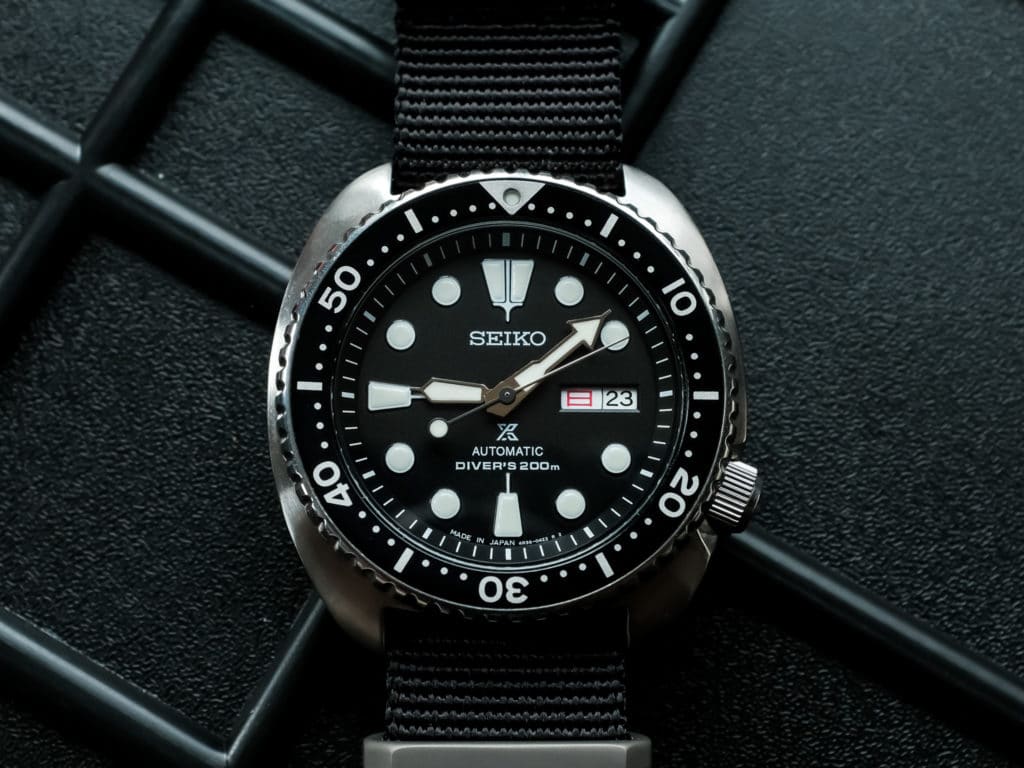
Equally important is the rotating bezel, which is a hallmark of dive watches. This unidirectional bezel lets you track elapsed time underwater by aligning the zero marker (or “pip”) with the minute hand. It’s not simply a design detail. It’s a timing tool that once served as a diver’s lifeline while they were under water. You also need to check for luminescence on the dial and hands. Good lume charges quickly under sunlight and glows brightly underwater where natural light fades quickly. This detail can separate a trustworthy tool watch from something more design inclined.
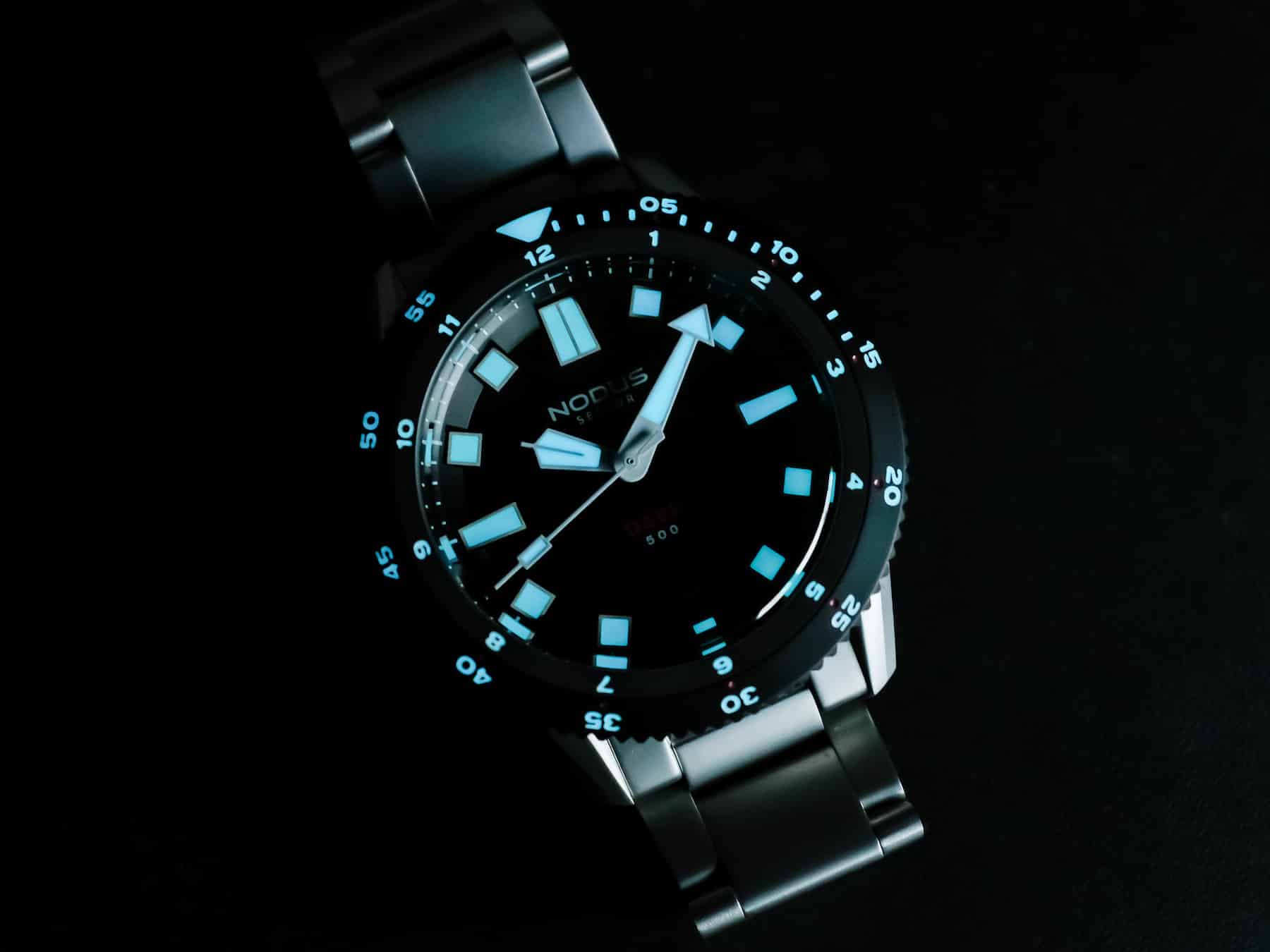
Beyond surface features, attention to case construction can reveal whether a dive watch is built to last. A proper diver will use gaskets at all potential entry points (like the crown, caseback, and crystal) to seal out water. Screw-down crowns and screw-down casebacks add even more security and ensure these weak spots remain tightly closed under pressure. Some models also include a helium escape valve, but unless you’re saturation diving in a commercial setting, they aren’t totally necessary.

Co-Founder and Senior Editor
Kaz has been collecting watches since 2015, but he’s been fascinated by product design, the Collector’s psychology, and brand marketing his whole life. While sharing the same strong fondness for all things horologically-affordable as Mike (his TBWS partner in crime), Kaz’s collection niche is also focused on vintage Soviet watches as well as watches that feature a unique, but well-designed quirk or visual hook.
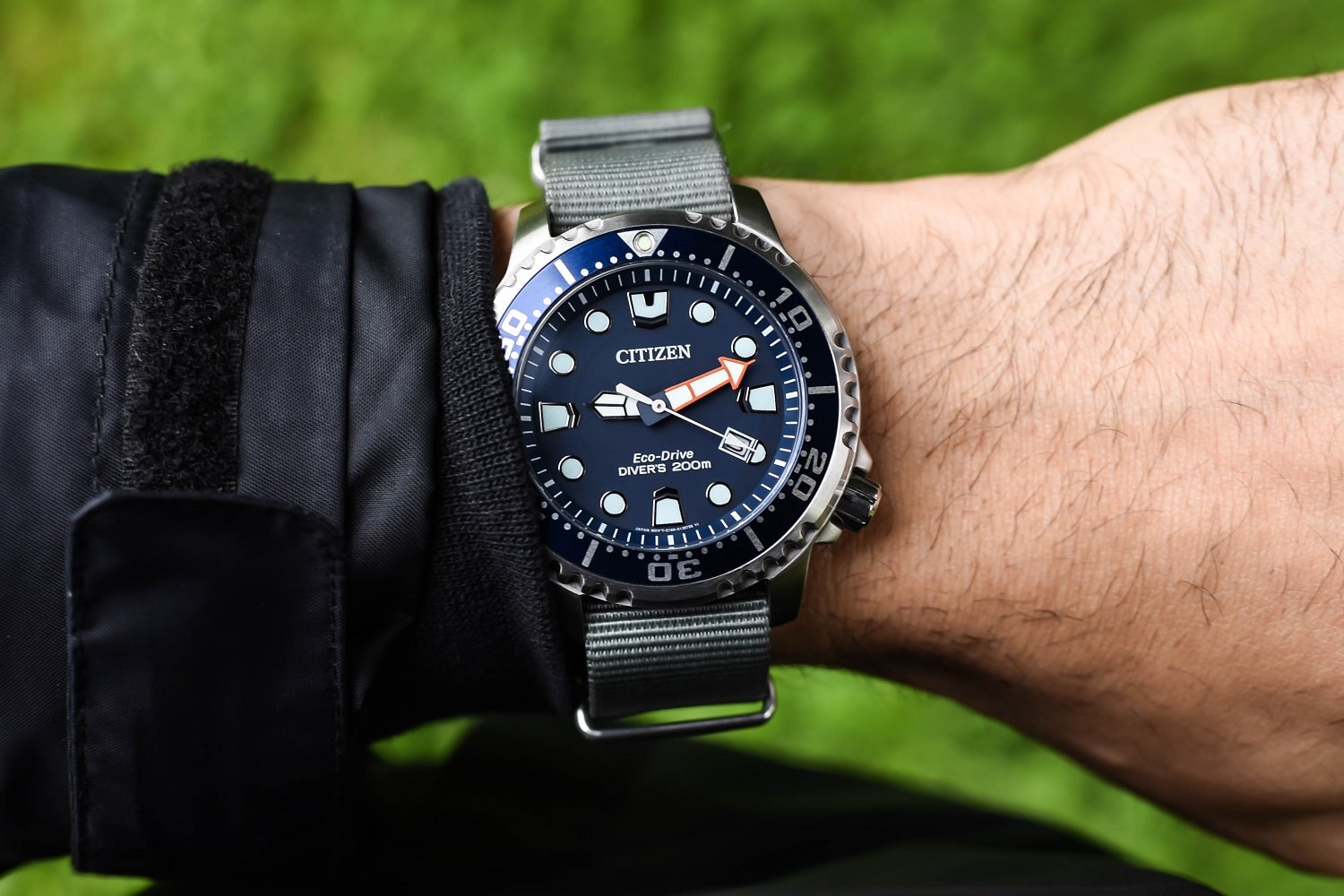
Great article (a few typos Kaz!)
Appreciate seeing some divers I wasn’t aware of.
Mike:
Thank you! Yup apologies for that – catching and fixing those errors now.
Best,
-Kaz
Revue Thommen has several watches under $1,000 in dive and dive/GMT.
Zak:
I don’t know enough about this brand and whether or not to weigh in on if they are a good fit for the list.
-Kaz
Maybe a nod to the Zodiac Super Sea Wolf? I suppose it comes in just above the price constraints here. Maybe the Longines Hydroconquest, given grey market pricing?
Yea I was trying to really lean on mfg MSRP as the $1k threshold, which is why the Super Sea Wolf and the Hydroconquest didnt make the list. But honestly maybe it’s worth creating a peripheral list of “honorary mentions” that includes grey market pricing as the threshold.
-Kaz
I went swimming with my Invicta provDiver and it leaked,They said only guaranteed for 35 days from purchase.It was 200 m water resistant??Beware
Great article and podcast episode. Thanks, Kaz!
For your consideration, Marathon’s MSAR dive watches (the 36mm) are less than $1k. The quartz version is around $720 (around $650 during Marathon’s labor day sale recently) and the sellita auto is around $990. Like you both, I love a good quartz diver!
Ohhhh good call with Marathon! Let me check those out and get them slotted into the next update for this piece. Thank you!
-Kaz
Hi Kaz,
This is a great article that cuts through the BS, plus I’ve owned or own quite a few of the watches in the list.
Not sure how the pricing works in the US but in my native U.K., the Christopher Ward C60 comes in at £915 or £795 on strap. I understand that the brand can be a bit marmite but I think it offers the consumer some features and finishing not usually seen in the £1000 range
John:
Thank you for the kind words!
Ohhh interesting – I thought Chr Ward went crazy up-marketing and started MSRP’ing at like $2k or something. Let me check them out again and reassess whether to include them on the next update for this article. I’ve already loved the C60 designs – they used to do a white dial/green bezel model many many years ago that’s always been on my mind.
Best,
-Kaz
Hey Kaz,
Glad that Certina made the list. Sometimes overlooked but very solid value. What about the Halios Seaforth? I had a Gen 2 and selling it was my one watch regret. Gen 4 will be $775.
Take care,
Mark
Mark!
I’d have to ask Mike’s opinion on the Seaforth since he’s spent more time with it then I have but I think just from what I know anecdotally it can totally make the cut – thank you!
-Kaz
Good list and you have me looking at Baltic again. I’m partial to the Monster and think it’s a future classic so I’d add that to the list.
Hey Kaz,
Thanks for the comprehensive article. Super useful and a fun read.
I’ve come across the Monterey Watch Company recently. I happen to have met the owner (a client of mine) and I have the Great White diver from the brand. You get sapphire, NH 35 clone movement, great lume, nice jubilee bracelet with milled clasp all for under $250! Highly recommend you check them out.
Appreciate you guys!
Tommy
Tommy:
Thank you for the kind words – glad you enjoyed the article! I hadn’t heard of Monterey Watch Company before but I’ll check them out – from your description and that price point it sounds like they’re certainly offering a ton of value and quality.
Best,
-Kaz
Glad to see the Certina 38 DS Diver on the list. I just purchased the black dial two tone. It’s an incredible watch for the money.
Excellent list – and very comprehensive!
I’m probably an outlier in the watch community. I don’t care much about others’ perceptions (I’m with you on the Invicta Pro Diver). I care more about robustness, and how much I enjoy looking at it. I prefer divers because of the way the bezel frames the dial, because I’m not careful about wetting, and because I actually use the dial to time things pretty much every day.
I’ve always liked Scurfa, but the thickness of the Diver 1 has kind of put me off. I have a Deep Blue that’s just too thick to be comfortable – it sort of set my limit for me. I tend to evaluate potential comfort by (diameter/thickness > 3.24, which is the Seiko Samurai).
Have you looked at the Scurfa Treasure Seeker? The dial is quite interesting, good specs, wears comfortably.
How about NTH’s offerings? I have a Thresher which I really enjoy.
Great list, something I wish existed when I started out, maybe it did but I never found it.
It’s worth looking at Unimatic watches, decent affordable, reliable dive watches, Seiko movements in some.
Fantastic article and a great selection of lovely watches; love the fact that the selection include but welll-known and lesser-known brands. As ever with TBWS! You guys are great champions of, and spokespeople for, smaller brands.
One submission for your consideration is the Citizen Promaster Aqualand JP2000-08E. Great watch and as reliable as they come!
Cheers from England!
How about Lorier, been hearing a lot about this ?
Nitin:
Lorier is a good one – at the time of writing this piece they were having inventory issues but I’ll check in on how they’re doing to see if they’re past all that now. Would be nice to add them to the list.
Thank you so much!
-Kaz
There is also a green bezel available with the Casio.
Three words: Glycine Combat Sub. Generally regarded as the best value in watchmaking under USD 500. Any reason why it wasn’t included? Otherwise, your selections are spot on, good work.
Amko:
Ahhh great catch! I’ll get it added here when we revisit the list. Thank you!
-Kaz
I can relate to the “first dive watch” phenomena and the choice for my first was inspired from an article right here on TBWS! The Citizen Promaster Diver (BN0151-09L) remains my all-time favorite, and even though I’ve added a few more to the “dive list,” the Promaster remains the absolute go-to when I head to the water.
What about the hydroconquest from Longines? New GMT release included recently
Kaz,
As a former commercial diver, dive instructor and scientific diver I’d like to make two comments. First, you are correct that many divers today wear computers instead of dive watches, but those of us who dive for a living still wear a good dive watch as a backup for dive elapsed time. For that reason, the unidirectional bezel is important. If the bezel rotates in the clockwise direction, it makes the measured dive bottom time shorter than the actual time and exposes the diver to an increased chance of decompression sickness. Rotating counterclockwise makes the dive appear longer, giving the diver a safety margin when calculating decompression.
My second comment has to do with the hydrogen escape valve. Hydrogen slowly leaks into the watch when living in a saturation bell at depth. When divers complete a job, they ascend in the bell and decompress back to surface pressure. The decompression process is faster than the hydrogen is able to leak out, so the hydrogen valve is a one way valve to release the hydrogen during decompression. Otherwise, the internal hydrogen would push the watch crystal out of the watch.
Nice review of the watches otherwise.
No one ever, ever mentions the (MY) Rolex Deepsea 126660 – undisputed King of Dive Watches, owned by a diver and former soldier… is it too expensive or simply too much hunk of steel for mere mortals? My first watch was the Seiko Sports 100 I inherited from my father; throughout my military career I worked with a G-Shock, and after I educated my daughters I permitted myself this indulgence, 44mm in diameter, and no it’s not the Cameron Deep Blue, basic black for me. I’ll take the pepsi challenge with any Omega, tag or other any day.
Otherwise, a nice review thank you.
Nice article, sent it to friend looking for their first diver. Spot on with the steinhart’s, love my gmt diver!! Also have a revue gmt and really love that too but wish they would add a ceramic bezel option. One brand that always catches my attention is Helm; any thoughts?
All great watches. So many still you could review
I think personally the Sinn U1 is a very good divers watch. Maybe top 10 in the world
What strap (waffle) is that on your green Sumo? I have a gen 2 pepsi I was thinking of another strap for it… Currently blue, thoughts of red.
Where is the best, the real scuba diving watch: the Citizen Aqualand (the first one – anadigi)?
This is the best option if you want the best diving watch, a real toolwatch which was used by thousand divers during the las 40 years.